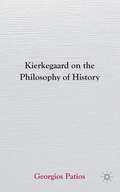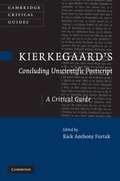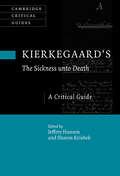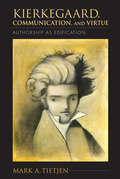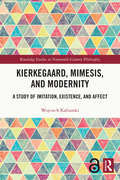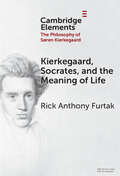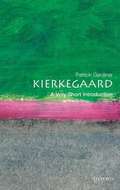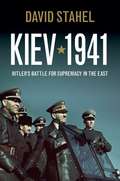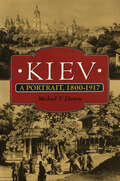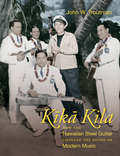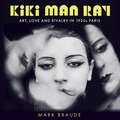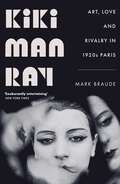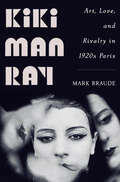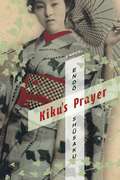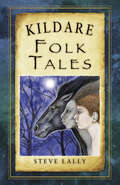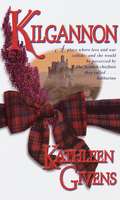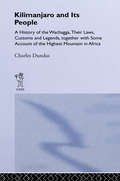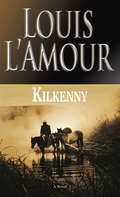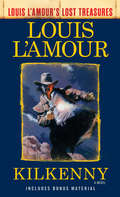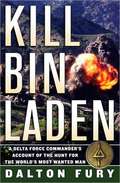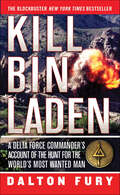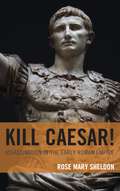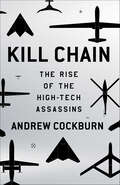- Table View
- List View
Kierkegaard on the Philosophy of History
by Georgios PatiosHistory doesn't have to mean only an effort to know the past. It can be instead, according to Kierkegaard, a willful and personal choice regarding the creation of the future. Kierkegaard offers us an amazing new approach to the problem of what is history and who makes it.
Kierkegaard's Concluding Unscientific Postscript: A Critical Guide
by Rick Anthony FurtakSoren Kierkegaard's Concluding Unscientific Postscript has provoked a lively variety of divergent interpretations for a century and a half. It has been both celebrated and condemned as the chief inspiration for twentieth-century existential thought, as a subversive parody of philosophical argument, as a critique of mass society, as a forerunner of phenomenology and of postmodern relativism, and as an appeal for a renewal of religious commitment. These new essays written by international Kierkegaard scholars offer a plurality of critical approaches to this fundamental text of existential philosophy. They cover hotly debated topics such as the tension between the Socratic-philosophical and the Christian-religious; the identity and personality of Kierkegaard's pseudonym 'Johannes Climacus'; his conceptions of paradoxical faith and of passionate understanding; his relation to his contemporaries and to some of his more distant predecessors; and, last but not least, his pertinence to our present-day concerns.
Kierkegaard's Fear and Trembling
by Daniel ConwayWritten by an international team of contributors, this book offers a fresh set of interpretations of Fear and Trembling, which remains Kierkegaard's most influential and popular book. The chapters provide incisive accounts of the psychological and epistemological presuppositions of Fear and Trembling; of religious experience and the existential dimension of faith; of Kierkegaard's understanding of the relationship between faith and knowledge; of the purported and real conflicts between ethics and religion; of Kierkegaard's interpretation of the value of hope, trust, love and other virtues; of Kierkegaard's debts to German idealism and Protestant theology; and of his seminal contributions to the fields of psychology, existential phenomenology and literary theory. This volume will be of great interest to scholars and upper-level students of Kierkegaard studies, the history of philosophy, theology and religious studies.
Kierkegaard's Muse: The Mystery of Regine Olsen
by Joakim GarffThe first biography of Kierkegaard's literary muse and one-time fiancée, from the author of the definitive biography of the philosopherKierkegaard's Muse, the first biography of Regine Olsen (1822–1904), the literary inspiration and one-time fiancée of Danish philosopher Søren Kierkegaard, is a moving portrait of a long romantic fever that had momentous literary consequences. Drawing on more than one hundred previously unknown letters by Regine that acclaimed Kierkegaard biographer Joakim Garff discovered by chance, the book tells the story of Kierkegaard and Regine's mysterious relationship more fully and vividly than ever before, shedding new light on her influence on his life and writings.Like Dante's Beatrice, Regine is one of the great muses of literary history. Kierkegaard proposed to her in 1840, but broke off the engagement a year later. After their break, they saw each other strikingly often, inside dimly lit churches, on the streets of Copenhagen, and on the paths along the old city ramparts, passing by without uttering a word.Despite or because of their separation in life, Kierkegaard made Regine his literary life companion, "that single individual" to whom he dedicated all his works. Garff shows how Regine became a poetic presence in the frequent erotic conflicts found throughout Kierkegaard's writings, from the famous "Seducer's Diary" account of their relationship to diary entries made shortly before his death in 1855. In turn, Regine remained preoccupied with Kierkegaard until her own death almost fifty years later, and her newly discovered letters, written to her sister Cornelia, reveal for the first time a woman of flesh and blood.A psychologically acute narrative that is as gripping as a novel, Kierkegaard's Muse is an unforgettable account of a wild, strange, and poignant romance that made an indelible mark on literary history.Some images inside the book are unavailable due to digital copyright restrictions.
Kierkegaard's The Sickness Unto Death: A Critical Guide (Cambridge Critical Guides)
by Sharon Krishek Jeffrey HansonThe Sickness unto Death (1849) is commonly regarded as one of Kierkegaard's most important works – but also as one of his most difficult texts to understand. It is a meditation on Christian existentialist themes including sin, despair, religious faith and its redemptive power, and the relation and difference between physical and spiritual death. This volume of new essays guides readers through the philosophical and theological significance of the work, while clarifying the complicated ideas that Kierkegaard develops. Some of the essays focus closely on particular themes, others attempt to elucidate the text as a whole, and yet others examine it in relation to other philosophical views. Bringing together these diverse approaches, the volume offers a comprehensive understanding of this pivotal work. It will be of interest to those studying Kierkegaard as well as existentialism, religious philosophy, and moral psychology.
Kierkegaard, Communication, and Virtue: Authorship as Edification
by Mark A. Tietjen“Tietjen offers the kind of approach that encourages us to put the emphasis where it rightly belongs: on Kierkegaard’s philosophical ideas.” —Notre Dame Philosophical ReviewsIn contrast to recent postmodern and deconstructionist readings, Mark A. Tietjen believes that the purpose behind Kierkegaard’s writings is the moral and religious improvement of the reader. Tietjen defends Kierkegaard against claims that certain features of his works, such as pseudonymity, indirect communication, irony, and satire are self-deceived or deceitful. Kierkegaard, Communication, and Virtue reveals how they are directly related to the virtues or moral issues being discussed. In fact, Tietjen argues, the manner of presentation is a critical element of the philosophical message being conveyed. Reading broadly in Kierkegaard’s writings, he develops a hermeneutics of trust that fully illustrates Kierkegaard’s aim to evoke faith in his reader.“Tietjen’s critique of deconstructionist readings of Kierkegaard along with an emphasis on employing a hermeneutic of trust clearly distinguishes his work from other treatments of Kierkegaard as a virtue ethicist and edifying writer.” —Sylvia Walsh, Stetson University
Kierkegaard, Mimesis, and Modernity: A Study of Imitation, Existence, and Affect (Routledge Studies in Nineteenth-Century Philosophy)
by Wojciech KaftanskiThis book challenges the widespread view of Kierkegaard’s idiosyncratic and predominantly religious position on mimesis. Taking mimesis as a crucial conceptual point of reference in reading Kierkegaard, this book offers a nuanced understanding of the relation between aesthetics and religion in his thought. Kaftanski shows how Kierkegaard's dialectical-existential reading of mimesis interlaces aesthetic and religious themes, including the familiar core concepts of imitation, repetition, and admiration as well as the newly arisen notions of affectivity, contagion, and crowd behavior. Kierkegaard’s enduring relevance to the malaises of our own day is firmly established by his classic concern for the meaning of human life informed by reflective meditation on the mimeticorigins of the contemporary age. Kierkegaard, Mimesis, and Modernity will be of interest to scholars and advanced students working on Kierkegaard, Continental philosophy, the history of aesthetics, and critical and religious studies.
Kierkegaard, Socrates, and the Meaning of Life (Elements in the Philosophy of S?ren Kierkegaard)
by Rick Anthony FurtakKierkegaard's lifelong fascination with the figure of Socrates has many aspects, but prominent among them is his admiration for the way Socrates was devoted to his divinely ordained mission as a philosopher. To have such a destiny, revealed through what one loves and is passionate about as well as through a feeling of vocation, is a necessary condition of leading a meaningful life, according to Kierkegaard. Examining what Kierkegaard has to say about the meaning of life requires looking at his conception of 'subjective truth,' as well as how he understands the ancient ideal of 'amor fati,' a notion that Nietzsche would subsequently take up, but that Kierkegaard understands in a manner that is distinctly his own, and that he sought to put into practice in his own existence. Our life is a work of art, but we are not the artist.
Kierkegaard: A Very Short Introduction
by Patrick GardinerScholars have largely misunderstood Soren Kierkegaard, remembering him chiefly in connection with the development of existentialist philosophy in this century. In a short and unhappy life, he wrote many books and articles on literary, satirical, religious and psychological themes, but the diversity and idiosyncratic style of his writing have contributed to a misunderstanding of his ideas. In this book--the only introduction to the full range of Kierkegaard's thought--Patrick Gardiner demonstrates how Kierkegaard developed his ideas and examines his thoughts in light of the doctrines on society developed by his contemporaries Marx and Feuerbach. Finally, he assesses the profound importance of Kierkegaard's ideas on the development of modern ways of thinking.
Kiev 1941: Hitler's Battle for Supremacy in the East
by David StahelIn just four weeks in the summer of 1941 the German Wehrmacht wrought unprecedented destruction on four Soviet armies, conquering central Ukraine and killing or capturing three quarters of a million men. This was the Battle of Kiev - one of the largest and most decisive battles of World War II and, for Hitler and Stalin, a battle of crucial importance. For the first time, David Stahel charts the battle's dramatic course and aftermath, uncovering the irreplaceable losses suffered by Germany's 'panzer groups' despite their battlefield gains, and the implications of these losses for the German war effort. He illuminates the inner workings of the German army as well as the experiences of ordinary soldiers, showing that with the Russian winter looming and Soviet resistance still unbroken, victory came at huge cost and confirmed the turning point in Germany's war in the East.
Kiev: A Portrait, 1800-1917
by Michael F. HammIn a fascinating "urban biography," Michael Hamm tells the story of one of Europe's most diverse cities and its distinctive mix of Ukrainian, Polish, Russian, and Jewish inhabitants. A splendid urban center in medieval times, Kiev became a major metropolis in late Imperial Russia, and is now the capital of independent Ukraine. After a concise account of Kiev's early history, Hamm focuses on the city's dramatic growth in the nineteenth and early twentieth centuries. The first historian to analyze how each of Kiev's ethnic groups contributed to the vitality of the city's culture, he also examines the violent conflicts that developed among them. In vivid detail, he shows why Kiev came to be known for its "abundance of revolutionaries" and its anti-Semitic violence.
Kika Kila: How the Hawaiian Steel Guitar Changed the Sound of Modern Music
by John W. TroutmanSince the nineteenth century, the distinct tones of k&299;k&257; kila, the Hawaiian steel guitar, have defined the island sound. Here historian and steel guitarist John W. Troutman offers the instrument's definitive history, from its discovery by a young Hawaiian royalist named Joseph Kekuku to its revolutionary influence on American and world music. During the early twentieth century, Hawaiian musicians traveled the globe, from tent shows in the Mississippi Delta, where they shaped the new sounds of country and the blues, to regal theaters and vaudeville stages in New York, Berlin, Kolkata, and beyond. In the process, Hawaiian guitarists recast the role of the guitar in modern life. But as Troutman explains, by the 1970s the instrument's embrace and adoption overseas also worked to challenge its cultural legitimacy in the eyes of a new generation of Hawaiian musicians. As a consequence, the indigenous instrument nearly disappeared in its homeland.Using rich musical and historical sources, including interviews with musicians and their descendants, Troutman provides the complete story of how this Native Hawaiian instrument transformed not only American music but the sounds of modern music throughout the world.
Kiki Man Ray: Art, Love and Rivalry in 1920s Paris
by Mark BraudeThe story of Alice Prin, aka Kiki -- who captivated 1920s Paris -- and her tumultuous relationship with photographer Man RayThough many have never heard her name, Alice Prin - Kiki de Montparnasse - was the icon of 1920s Paris. She captivated as a ground-breaking nightclub performer, wrote a bestselling memoir, sold out exhibitions of her paintings, and shared drinks with the likes of Pablo Picasso, Peggy Guggenheim, Marcel Duchamp and Gertrude Stein. She also shepherded along the career of the then-unknown American photographer: Man Ray.Following Kiki in the years between 1921 and 1929, when she lived and worked with Man Ray, Kiki Man Ray charts their decade-long entanglement and reveals how Man Ray - always the unabashed careerist - went on to become one of the most famous photographers of the twentieth century, enjoying wealth and fame, while Kiki's legacy was lost.But this isn't a story of an overbearing male genius and his defeated muse. During the 1920s it was Kiki, not Man Ray, who was the brighter of the two rising stars and a powerful figure among the close-knit community of models, painters, writers and café wastrels who made their homes in gritty Montparnasse. Following the couple as they created art, struggled for power and competed for fame, Kiki Man Ray illuminates for the first time Kiki's seminal influence on the culture of 1920s Paris, and challenges ideas about artists and muses, and the lines separating the two.(P) 2022 Hodder & Stoughton Limited
Kiki Man Ray: Art, Love and Rivalry in 1920s Paris
by Mark Braude'Exuberantly entertaining' NYT Book Review'Mark Braude's writing and subject make this book irresistible, as was Kiki herself.' Jim Jarmusch'A delightful, marvelously readable, meticulously-researched romp of a book, Kiki Man Ray brings to life not just the kaleidoscopically talented Kiki herself, but the endlessly fascinating Montparnasse milieu over which she reigned.' Whitney Scharer, author of THE AGE OF LIGHTThough many have never heard her name, Alice Prin - Kiki de Montparnasse - was the icon of 1920s Paris. She captivated as a ground-breaking nightclub performer, wrote a bestselling memoir, sold out exhibitions of her paintings, and shared drinks and ideas with the likes of Pablo Picasso, Peggy Guggenheim, and Marcel Duchamp. She also shepherded along the career of a then-unknown American photographer: Man Ray.Following Kiki in the years between 1921 and 1929, when she lived and worked with Man Ray, Kiki Man Ray charts their complicated entanglement and reveals how Man Ray - always the unabashed careerist - went on to become one of the most famous photographers of the twentieth century, enjoying wealth and prestige, while Kiki's legacy was lost.But this isn't a story of an overbearing male genius and his defeated muse. During the 1920s it was Kiki, not Man Ray, who was the brighter of the two rising stars and a powerful figure among the close-knit community of models, painters, writers and café wastrels who made their homes in gritty Montparnasse. Following the couple as they created art, struggled for power and competed for fame, Kiki Man Ray illuminates for the first time Kiki's seminal influence on the culture of 1920s Paris, and challenges ideas about artists and muses, and the lines separating the two.'Kiki de Montparnasse was more than a muse - she was a vivacious, independent woman whose talent and magnetism helped make Paris the center of the art world in the 1920s. In Mark Braude's riveting cultural history, the Queen of Montparnasse rises again. This is a lively and compassionate tribute to the chanteuse, model, and portraitist who held center stage in her life, and who inspired some of the finest Surrealist art of the twentieth century.' Heather Clark, author of Pulitzer Prize-finalist Red Comet: The Short Life and Blazing Art of Sylvia Plath
Kiki Man Ray: Art, Love, and Rivalry in 1920s Paris
by Mark BraudeA dazzling portrait of Paris’s forgotten artist and cabaret star, whose incandescent life asks us to see the history of modern art in new ways. In freewheeling 1920s Paris, Kiki de Montparnasse captivated as a nightclub performer, sold out gallery showings of her paintings, starred in Surrealist films, and shared drinks and ideas with the likes of Jean Cocteau and Marcel Duchamp. Her best-selling memoir—featuring an introduction by Ernest Hemingway—made front-page news in France and was immediately banned in America. All before she turned thirty. Kiki was once the symbol of bohemian Paris. But if she is remembered today, it is only for posing for several now-celebrated male artists, including Amedeo Modigliani and Alexander Calder, and especially photographer Man Ray. Why has Man Ray’s legacy endured while Kiki has become a footnote? Kiki and Man Ray met in 1921 during a chance encounter at a café. What followed was an explosive decade-long connection, both professional and romantic, during which the couple grew and experimented as artists, competed for fame, and created many of the shocking images that cemented Man Ray’s reputation as one of the great artists of the modern era. The works they made together, including the Surrealist icons Le Violon d’Ingres and Noire et blanche, now set records at auction. Charting their volatile relationship, award-winning historian Mark Braude illuminates for the first time Kiki’s seminal influence not only on Man Ray’s art, but on the culture of 1920s Paris and beyond. As provocative and magnetically irresistible as Kiki herself, Kiki Man Ray is the story of an exceptional life that will challenge ideas about artists and muses—and the lines separating the two.
Kiku's Prayer: A Novel (Weatherhead Books on Asia)
by Shūsaku EndōKiku's Prayer is told through the eyes of Kiku, a self-assured young woman from a rural Japanese village who falls in love with Seikichi, a devoted Catholic man. Practicing a faith still banned by the government, Seikichi is imprisoned but refuses to recant under torture. Kiku's efforts to reconcile her feelings for Seikichi's religion with the sacrifices she makes to free him mirror the painful, conflicting choices Japan faced as a result of exposure to modernity and the West. Seikichi's persecution exemplifies Japan's insecurities, and Kiku's tortured yet determined spirit represents the nation's resilient soul.Set in the turbulent years of the transition from the shogunate to the Meiji Restoration, Kiku's Prayer embodies themes central to Endo Shusaku's work, including religion, modernization, and the endurance of the human spirit. Yet this novel is much more than a historical allegory. It acutely renders one woman's troubled encounter with passion and spirituality at a transitional time in her life and in the history of her people. A renowned twentieth-century Japanese author, Endo wrote from the perspective of being both Japanese and Catholic. His work is often compared with that of Graham Greene, who himself considered Endo one of the century's finest writers.
Kildare Folk Tales
by Steve LallyCounty Kildare abounds in folk tales, myths and legends and a selection of the best, drawn from historical sources and newly recorded local reminiscence, have been brought to life here by professional storyteller Steve Lally. Included in this collection are the exploits of the Wizard Earl of Kildare who lived at Maynooth Castle, the legend of the lonely ‘Pooka Horse’ said to dwell amongst the ruins of Rathcoffey Castle, the story of St Bridgid, the patron saint of County Kildare, and the tale of the time the Devil decided to make a house call. Full of wit and wisdom, these tales tell of the strange and macabre; memories of magic and otherworlds; and proud recollections of county heroes such as Dan Donnelly, Ireland’s first Heavy Weight Boxing Champion. The captivating stories, brought to life with unique illustrations from the author, will be enjoyed by readers time and again.
Kilgannon (Kilgannon #1)
by Kathleen GivensA place where love and war collide--and she would be possessed by the Scottish chieftain they called . . . barbarianEnter a world of breathtaking romance and rugged adventure. Enter the world of Kilgannon--an unforgettable story of love and treachery in a great Scottish clan. Kathleen Givens's magnificent novel sweeps from Queen Anne's London to the Highland wilderness . . . and into the hearts of one proud, passionate family: the MacGannons of . . . Kilgannon.Mary Lowell wasn't interested in marriage despite her aunt's determination to find her a husband by the end of the London Season. Then Alex MacGannon, Earl of Kilgannon, strode into the ballroom and commanded her heart. They called him a barbarian, a rough-hewn Scot--chieftain of clan MacGannon. They said no woman could hold him, as he set sail on the high seas. But Alex returned to claim Mary Lowell as his own, to carry her off to Scotland, to his magnificent ancestral castle, Kilgannon. And as the Highlands are torn by rebellion, Mary will find passion--and danger--in the rugged land she would now call home.Watch for the next book in the magnificent Kilgannon saga: The Wild Rose of Kilgannon, coming in November 1999 from Dell.From the Paperback edition.
Kilimanjaro and Its People: A History of Wachagga, their Laws, Customs and Legends, Together with Some
by Charles DundasFirst published in 1924, this account was written by a Senior Commissioner of the Tanganyika Territory.
Kilkenny
by Louis L'AmourKilkenny wasn't looking for trouble when he entered the Clifton House stage station, but trouble found him when a reckless youngster named Tetlow challenged him, drew his gun, and paid for it with his life.Looking to escape a reputation that he never wanted, Kilkenny settles in the lonely mountain country of Utah, planning to ranch a high, lush valley. But the past is on his trail. Jared Tetlow is a powerful rancher determined to run his vast herd on the limited grasslands there--whether he has to buy out the local ranchers, run them out, or kill them. He'll cut down anyone who stands in his way, especially a man he already despises: the gunman named Kilkenny--the man who killed his son.From the Paperback edition.
Kilkenny: A Novel (Louis L'Amour's Lost Treasures)
by Louis L'AmourAs part of the Louis L’Amour’s Lost Treasures series, this edition contains exclusive bonus materials! Kilkenny wasn’t looking for trouble when he entered the Clifton House stage station, but trouble found him when a reckless youngster named Tetlow challenged him, drew his gun, and paid for it with his life. Looking to escape a reputation that he never wanted, Kilkenny settles in the lonely mountain country of Utah, planning to ranch a high, lush valley. But the past is on his trail. Jared Tetlow is a powerful rancher determined to run his vast herd on the limited grasslands there—whether he has to buy out the local ranchers, run them out, or kill them. He’ll cut down anyone who stands in his way, especially a man he already despises: the gunman named Kilkenny—the man who killed his son.Louis L’Amour’s Lost Treasures is a project created to release some of the author’s more unconventional manuscripts from the family archives. In Louis L’Amour’s Lost Treasures: Volumes 1, Beau L’Amour takes the reader on a guided tour through many of the finished and unfinished short stories, novels, and treatments that his father was never able to publish during his lifetime. L’Amour’s never-before-seen first novel, No Traveller Returns, will also be released as a Lost Treasures publication, followed by Louis L’Amour’s Lost Treasures: Volume 2. Additionally, many beloved classics will be rereleased with an exclusive Lost Treasures postscript featuring previously unpublished material, including outlines, plot notes, and alternate drafts. These postscripts tell the story behind the stories that millions of readers have come to know and cherish.
Kill Bin Laden: A Delta Force Commander's Account of the Hunt for the World's Most Wanted Man
by Dalton FuryThis synopsis is taken from the front side cover of the book: "The mission was to kill the most wanted man in the world - an operation of such magnitude that it couldn't be handled by just any military or intelligence force. The best America had to offer was needed. As such, the task was handed to roughly forty members of America's super secret counterterrorist forces Operational Detachment Delta; more popularly, the elite and mysterious unit Delta Force. The American generals were flexible. A swath of hair, a drop of blood, or simply a severed finger wrapped in plastic would be sufficient. Delta's orders were to go into harm's way and prove to the world bin Laden had been terminated. These Delta warriors had help; a dozen of the British Queen's elite commandos, another dozen or so Army Green Berets, and six intelligence operators from the CIA laid the groundwork by providing cash, guns, bullets, intelligence, and interrogation skills to this clandestine military force. Together, this team waged a modern siege of epic proportions against bin Laden and his seemingly impenetrable cave sanctuary burrowed deep in the Spin Ghar mountain range in eastern Afghanistan. Over the years, since the battle ended, scores of news stories have surfaced offering tidbits about what actually happened in Tora Bora. Most of it is conjecture and speculation. This is the real story of the operation, the first eyewitness account of the Battle of Tora Bora, and the first book to detail just how close Delta force came to capturing bin Laden, how close U.S. bombers and fighter aircraft came to killing him, and exactly why he slipped through our fingers. Lastly, this is an extremely rare inside look at the shadowy world of Delta Force and a detailed account of those warriors in battle."
Kill Bin Laden: A Delta Force Commander's Account of the Hunt for the World's Most Wanted Man
by Dalton FuryThe New York Times–bestselling first-hand account of a Delta Force commando’s hunt for the Al-Qaida leader in the months after 9/11.The mission was to kill the most wanted man in the world—an operation of such magnitude that it couldn’t be handled by just any military or intelligence force. The best America had to offer was needed. As such, the task was handed to roughly forty members of America’s supersecret counterterrorist unit formally known as 1st Special Forces Operational Detachment-Delta; more popularly, the elite and mysterious unit Delta Force.Told by senior ranking military officer Dalton Fury, this is the real story of the operation, the first eyewitness account of the Battle of Tora Bora, and the first book to detail just how close Delta Force came to capturing bin Laden in late 2001, mere months after the September 11th attacks on the United States were carried out on his orders.In this rare look inside the shadowy world of Delta Force, Fury details just how close US bombers and fighter aircraft came to killing bin Laden, and exactly why he slipped through their fingers.
Kill Caesar!: Assassination in the Early Roman Empire
by Rose Mary Sheldon&“Why were Rome&’s first emperors—the good, the bad, and the ugly—so vulnerable to conspiracies and assassination? . . . an expert analysis . . . compelling.&” —Adrienne Mayor, author of The Poison King: The Life and Legend of Mithradates and Rome&’s Deadliest Enemy Exploring the history of internal security under the first Roman dynasty, this groundbreaking book answers the enduring question: If there were 9,000 men guarding the emperor, how were three-quarters of Rome&’s leaders assassinated? Rose Mary Sheldon traces the evolution of internal security mechanisms under the Julio-Claudians, evaluating the system that Augustus first developed to protect the imperial family and the stability of his dynasty. Yet in spite of the intensive precautions taken, there were multiple attempts on his life. Like all emperors, Augustus had a number of competing constituencies—the senate, the army, his extended family, the provincials, and the populace of Rome—but were they all equally threatening? Indeed, the biggest threat would come from those closest to the emperor—his family and the aristocracy. Even Roman imperial women were deeply involved in instigating regime change. By the fourth emperor, Caligula, the Praetorian Guards were already participating in assassinations, and the army too was becoming more politicized. Sheldon weighs the accuracy of ancient sources: Does the image of the emperor presented to us represent reality or what the people who killed him wanted us to think? Were Caligula and Nero really crazy, or did senatorial historians portray them that way to justify their murder? Was Claudius really the fool found drooling behind a curtain and made emperor, or was he in on the plot from the beginning? These and other fascinating questions are answered as Sheldon concludes that the repeated problem of &“killing Caesar&” reflected the empire&’s larger dynamics and turmoil.
Kill Chain: The Rise of the High-Tech Assassins
by Andrew CockburnAn essential and page-turning narrative on the history of drone warfare from journalist Andrew Cockburn, exploring how this practice emerged, who made it happen, and the real consequences of targeted killing.Assassination by drone is a subject of deep and enduring fascination. Yet few understand how and why this has become our principal way of waging war. Kill Chain uncovers the real and extraordinary story; its origins in long-buried secret programs, the breakthroughs that made UAV operations possible, the ways in which the technology works and, despite official claims, does not work. Taking the reader inside the well-guarded world of national security, the book reveals the powerful interests - military, CIA and corporate - that have led the drive to kill individuals by remote control. Most importantly of all, the book describes what has really happened when the theories underpinning the strategy -- and the multi-billion dollar contracts they spawn -- have been put to the test. Drawing on sources deep in the military and intelligence establishments, Andrew Cockburn's Kill Chain unveils the true effects, as demonstrated by bloody experience, of assassination warfare, a revelation that readers will find surprising as well as shocking.
